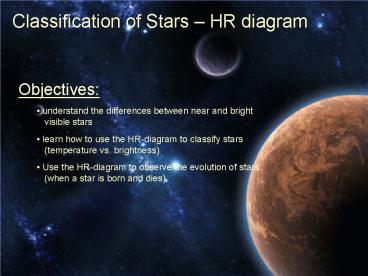Classification of Stars HR diagram - PowerPoint PPT Presentation
1 / 14
Title:
Classification of Stars HR diagram
Description:
Use the HR-diagram to observe the evolution of stars (when ... Arcturus. 36 -0.1 -5.5 -0.3. Betelgeuse. 520 .08. Deneb. 1600. 1.3 -6.9. 32.6 ly. View from Earth ... – PowerPoint PPT presentation
Number of Views:1785
Avg rating:3.0/5.0
Title: Classification of Stars HR diagram
1
Classification of Stars HR diagram
- Objectives
- understand the differences between near and
bright - visible stars
- learn how to use the HR-diagram to classify
stars - (temperature vs. brightness)
- Use the HR-diagram to observe the evolution of
stars - (when a star is born and dies)
2
HR-diagram classifies stars using temperature
magnitude
(brightness) HR-diagram Hertzbrung-Russell
diagram
3
Star color and Temperature Lets review the
visible color spectrum What do our eyes see?
Low Energy
High Energy
wavelength
R O Y G B I V
4
Star color and Temperature
Yellow
Blue
RED
30,000 K
2,500
6,000
Hot stars
Cool stars
Long wave lengths
Short wavelengths
R O Y G B I
V
5
Measuring the Brightness of a star Stellar
Brightness
Magnitude the brightness of a star
Magnitude is measured using (-) and () numbers
the more (-) the number, the brighter the
more (), the dimmer the star
- Apparent Magnitude
- A stars brightness as it appears from earth
- factors controlling apparent magnitude
- how big the star
- how hot the star
- how far away star
Which is brighter -5 star or 5 star ?
6
Apparent Magnitude of various objects
North Star
Full Moon
Naked eye
Pluto
HST
SUN
Venus
OBJECT
Sirius
Apparent Magnitude
-26.5
-12.5
-4.1
-1.4
2.0
6.0
15
28
7
- Absolute Magnitude
- measures the actual brightness
- two stars with the same absolute magnitude
- would not be the same apparent magnitude
- WHY?
- To compare absolute brightness
- use a standard distance of 32.6 light-years
- away from earth
Example
Apparent Magnitude
Absolute magnitude
-26.7
5
bright
dim
Earth
32.6 ly
8
Distance, Apparent Magnitude, and
Absolute Magnitude of Some Stars
32.6 ly
View from Earth
Distance Light-years
Apparent Magnitude
Absolute Magnitude
Name
NA
-26.7
5.0
Sun
4.27
0.0
4.4
Alpha Centauri
Sirius
8.70
-1.4
1.5
-0.1
Arcturus
36
-0.3
-5.5
520
.08
Betelgeuse
1.3
-6.9
1600
Deneb
So, which star is biggest to smallest?
9
Brightness scale Using Absolute Magnitude
Deneb
Betelgeuse
Arcturs
Sirius
Centauri
Sun
0
1
3
5
7
9
-1
-3
-5
-7
Bright
Dim
The brighter, the bigger the star
10
How are stars classified? the
Hertzsprung-Russell Diagram (HR-diagram)
-10
O
B
A
F
G
K
M
Very Bright
-5
Super Giants and Red Giants
0
Absolute Magnitude
Main Sequnce
5
10
White Dwarfs
Very Dim
20
10,000
14,000
20,000
3000
5000
7000
Surface Temperature (K)
11
Oh, Be A Fine Guy (or Gal), Kiss Me
O0O1..O9 B0..B9 A0..A9 F
Hottest
Coolest
12
HR-Diagram
Cool, bright
The Brighter, The Hotter
The cooler, the dimmer
Hot, dim
10,000
14,000
20,000
3000
5000
7000
Surface Temperature (K)
13
(No Transcript)
14
Stellar evolution
HR-Diagram
Variable Star stage
Red Giant Stage
Dust and gasses
Protostar
Planetary Nebula Stage
Main Sequence Star
Black Hole Stage
White Dwarf
10,000
14,000
20,000
3000
5000
7000
Surface Temperature (K)































